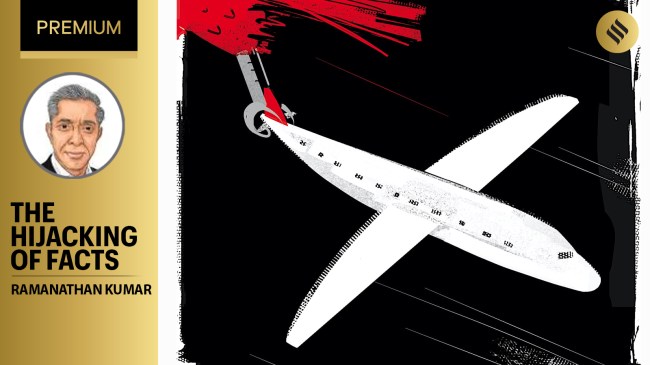Opinion ‘IC 814: The Kandahar Hijack’: Why Bollywood gets intelligence and security work so wrong
Blanket restrictions on retired personnel of intelligence and security agencies are counter-productive, as they discourage the knowledgeable from educating the people on issues in which they have a legitimate interest
 "The shortcomings of films and series like IC 814: The Kandahar Hijack which claim to be “inspired by real events”, but end up presenting a misleading and distorted version of reality, are related to a common malaise: Half-baked research."(Netflix India/Express Archives)
"The shortcomings of films and series like IC 814: The Kandahar Hijack which claim to be “inspired by real events”, but end up presenting a misleading and distorted version of reality, are related to a common malaise: Half-baked research."(Netflix India/Express Archives) The hijacking of Indian Airlines flight IC 814 from Kathmandu to Kandahar on Christmas Eve, 1999, which culminated, a week later, in the humiliating release of three jailed terrorists — of whom two were Pakistanis — in exchange for the passengers and crew on board, was a searing experience for India’s intelligence, national security and diplomatic establishments.
From the early 1990s, Indian intelligence had been engaged in a protracted, covert war against Pakistan’s ISI, which had been exploiting the weaknesses in Nepal’s security architecture and the open Indo-Nepal border to mount offensive, plausibly deniable operations against India. This included the infiltration and exfiltration of terrorists trained in Pakistan, smuggling of high-grade explosives and weapons for attacks in India and the infusion into the Indian market of counterfeit Indian currency printed in Pakistan to augment the ISI’s war-chest and destabilise the Indian economy. From the mid-1990s, however, unpublicised but effective security cooperation between Nepal and India foiled many of the ISI’s designs. The plots disrupted are too numerous to recount. As the 20th century drew to a close, Indian intelligence appeared to be gaining the upper hand in the shadowy battle against their Pakistani adversaries in Nepal.
Then came the hijacking of IC 814 which took the Indian agencies by surprise. That Pakistan, the ISI and its proxies were involved was, of course, not difficult to fathom and it did not take long for the terrorist organisation involved — the Harkat-ul-Mujahideen (HuM) — and the principal actors — whose primary motivation was to secure the release of Maulana Masood Azhar, chief propagandist of the HuM incarcerated in a jail in Jammu, to be identified. But the gold standard of intelligence is forewarning that leads to preemption. No amount of post facto investigation, however brilliant, is a substitute for foreknowledge and prevention in the intelligence business.
Indian intelligence was unable to prevent the hijacking of IC 814 because, in the months preceding the event, it had temporarily lost access to certain valuable assets and the consequences of the vulnerability thus created, at a time when Pakistan was vigorously pursuing its policy of bleeding India by a thousand cuts, were not adequately anticipated. This is not an unusual phenomenon in the world of intelligence and the assets were revived soon after the event but the damage had been done. That the terrorists had acquired Indian driving licences and passports, which enabled them to accomplish their mission with relative ease, was another bitter pill to swallow. Equally galling was the failure of the national crisis management system that allowed the aircraft to take off from Amritsar where it had been forced to land due to shortage of fuel. The reality that India was friendless in Afghanistan under the rule of the Taliban from 1996 to 2001 when the dominance of Pakistan and the ISI over its protégés was complete was also a far cry from the situation prevailing today.
This is the background and context that has been obfuscated, wittingly or unwittingly, in the Netflix series IC 814: The Kandahar Hijack which comes close to being a parody in its cavalier treatment of serious intelligence and security issues. The suggestion that the hijacking was masterminded by Osama bin Laden and Al Qaeda or that the plot originated in Afghanistan, rather than Pakistan, verges on the absurd. HuM leader, Maulana Fazlur Rehman Khalil, a prominent asset of Pakistan’s ISI, was doubtless a signatory to the famous fatwa issued by bin Laden’s International Islamic Front in 1998 against the “Jews and Crusaders” but, unlike Masood Azhar’s closest associates, the Al Qaeda leadership had no interest in securing the release of the HuM’s portly propagandist who subsequently went on to form his own organisation after falling out with Khalil over control of the HuM’s assets. Speculative reports in the Pakistani media about the presence of the Al Qaeda-Sipah-e-Sahaba Pakistan (SSP)-HuM linked Pakistani terrorist, Amjad Farooqi among the hijackers cannot be taken as an established fact, absent any corroborating evidence. The depiction of the R&AW representative in Kathmandu and the assertion that Al Qaeda smuggled 17 kg of RDX into the aircraft in the Nepalese capital both beggar belief. And, finally, as the series itself acknowledges, the names of the Pakistani terrorist Ahmed Omar Saeed Sheikh and Mushtaq Ahmed Zargar of the Kashmiri terrorist organisation Al Umar Mujahideen, were specifically included in the list of terrorists whom the hijackers wanted to be released at the behest of the ISI which spared no effort to twist the knife once India’s helplessness became obvious.
The shortcomings of films and series like IC 814: The Kandahar Hijack which claim to be “inspired by real events”, but end up presenting a misleading and distorted version of reality, are related to a common malaise: Half-baked research. This, in turn, raises the related issue of the progressively tighter restrictions imposed on the retired personnel of our intelligence and security agencies who have been barred from writing on subjects pertaining to their specialised domains without prior vetting by the organisations in which they served. These blanket restrictions are counterproductive, for they discourage the knowledgeable from educating the public on matters in which the latter have a legitimate interest. Short of divulging sensitive operational details, especially sources and methods, the disclosure of which is likely to have an adverse impact on national security, retired personnel of our intelligence and security establishments should be encouraged to express their views, perspectives and unique insights in public without inhibition. A policy to the contrary risks impoverishing the public discourse on matters vital to our national security.
The writer is a former special secretary in the Research & Analysis Wing. Views expressed are personal




